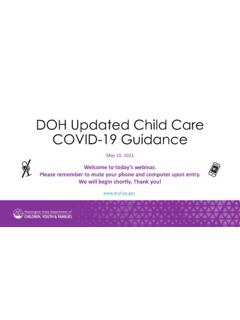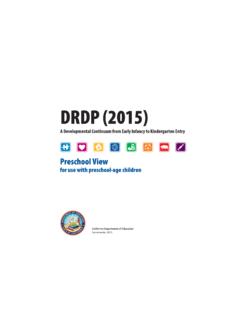Transcription of Parent-Child Interactions: A Home Visitor’s Guide
1 Page 1 Alberta Home Visitation Network Association Parent-Child Interactions: A Home Visitor s Guide 03/09 Contact Information: AHVNA Phone: 780-429-4787 Email: Ensuring the Quality, Accountability and Sustainability of Home Visitation Programs Parent-Child Interactions: A Home Visitor s Guide Home visitation is based on the knowledge that early life experiences estab-lished by Parent-Child interactions play a major role in the developmental outcomes for children.
2 Home visitation, by its nature, provides an opportu-nity to assess and enhance the Parent-Child interactions in the natural con-text of the family home and community. Home visitors in essence have the optimal view to observe and influence the development of positive Parent-Child interactions. The tool kit, Parent-Child Interactions: A Home Visitor s Guide , provides home visitors with tips and tools to make the most of the opportunity to observe and influence Parent-Child interactions.
3 Positive Parent-Child Interactions Positive Parent-Child interactions are powerful protective factors for children. The hallmark of these positive interactions are characterized as child focused responsive warm sensitive and are coupled with the following: clear expectations limits logical consequences attention to safety Infants send signals to their parents, crying when hungry or in discomfort, and cooing to engage in emotional interactions. When parents respond in a warm, caring manner to an infant s signals, the infant quickly learns to rely on the par-ent.
4 When an infant coos for the affection of the parent and the parent responds with positive affect, the parent and child form an emotional Healthy at-tachment or emotional bonds between the parent and child play a central role in regulating the infant s or child s experience of hunger, discomfort, and stress. The parental response optimally will assist the infant or child from hunger to satisfied, from discomfort to comfort, and from stress to stress recovery. 1 Positive Parent-Child interactions are the basis from which children are able to explore and experience the world of relationships, objects, cause and effect, and problem solving.
5 As the child explores and learns, the Parent-Child relationship functions as a safe and secure base and as a source of comfort for the develop-ing Page 2 Alberta Home Visitation Network Association Parent-Child Interactions: A Home Visitor s Guide 03/09 Contact Information: AHVNA Phone: 780-429-4787 Email: Ensuring the Quality, Accountability and Sustainability of Home Visitation Programs These positive interactions create resilient children by fostering trust security curiosity autonomy belief in child s abilities Parent-Child interactions significantly influence the child s physical growth behaviour patterns social-emotional development early language formation literacy academic outcomes Recent research by Schore (2001)
6 Demonstrated that infant brain develops in response to regular social interaction with a caregiver. Purpose of Observing Parent-Child Interactions The purpose of observing Parent-Child interactions is to determine both the strengths and challenges in the interplay between parent and child . Positive Parent-Child interactions entail warm parental support that incorporates behaviours that convey: supportive presence; acceptance; positive affect; sensitivity; and, respon-siveness to the child s needs.
7 2 Goals to enhance positive Parent-Child interactions are developed from observa-tions and discussions with the parent. The aim is to facilitate a process that offers support, guidance, teaching, and coaching invites struggling or frustrated parents to believe in their capabilities to positively interact with their infant or child Assessing the scope of home visitation services The observation of Parent-Child interactions can determine if the needs of the par-ent and child are beyond the scope of home visitation services.
8 For example, par-ents that have significant mental health concerns depression, substance abuse or dependence, anxiety, personality disorder, post traumatic stress syndrome, or de-lusions may experience reduced capacities to respond appropriately to their in-fant or child . Cohn and Tronick (1989) revealed that infants as young as three months will react to simulated depression by their mother. These infants responded to their still-faced mothers, who were simulating depression, with heightened distress levels, increased protests and gaze aversion when they observed the non-responsive face Page 3 Alberta Home Visitation Network Association Parent-Child Interactions: A Home Visitor s Guide 03/09 Contact Information: AHVNA Phone: 780-429-4787 Email.
9 Ensuring the Quality, Accountability and Sustainability of Home Visitation Programs of their mother. Mothers suffering from depression may interact with their infant in a rough or intrusive manner or the Parent-Child interaction may be characterized by fear, helplessness, withdrawal, or low levels of responsiveness. 4 Reduced parental sensitivity to the infant s cries may set in motion a pattern of negative Parent-Child interactions with both parent and child experiencing frustration and distress.
10 A second example where additional expertise may be needed is when a parent is not able to perceive a child as a separate individual with separate needs. Parents who are unable to perceive their child s needs as separate from their own may describe their child as demanding and difficult or may feel rejected by their infant . These parents may respond to their feelings by rejecting both the child and the needs of the child . Infants are not able to understand the thoughts, feelings, and experiences of their parents, nor are they able to decide to go against their parents wishes to be diffi-cult.




